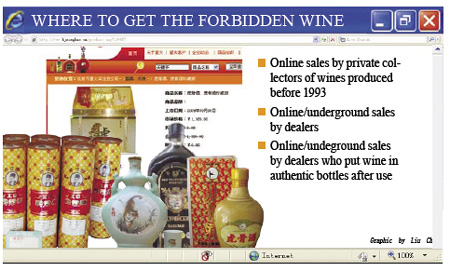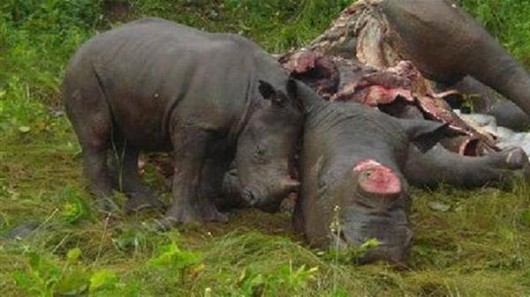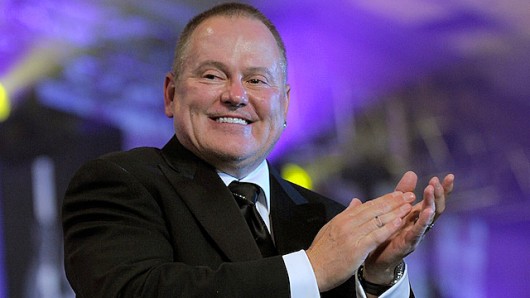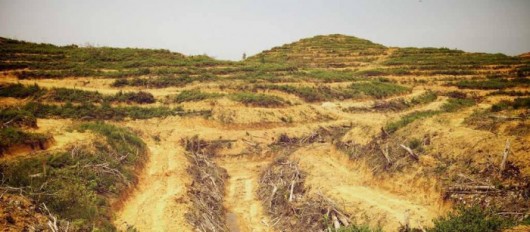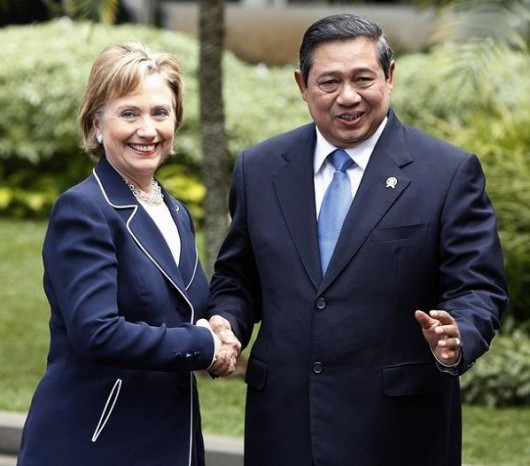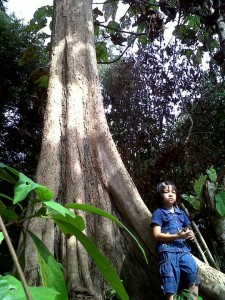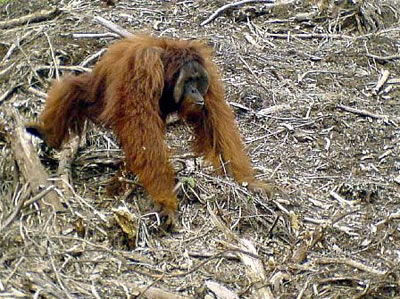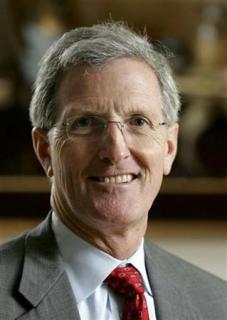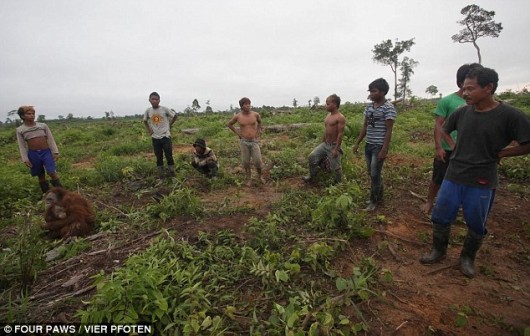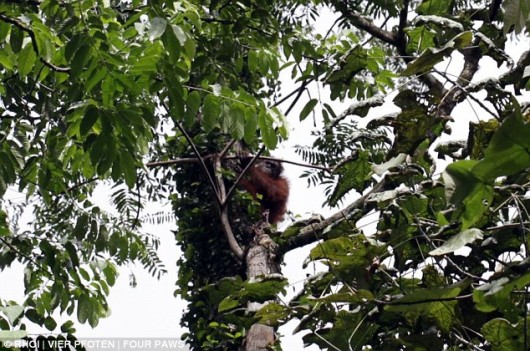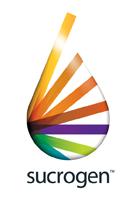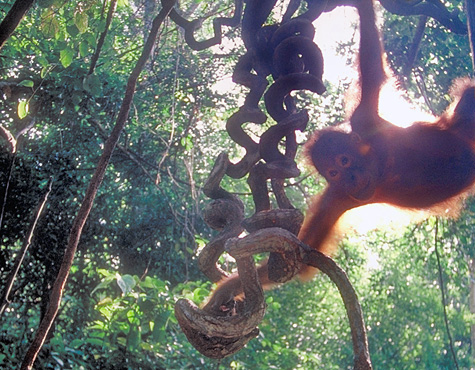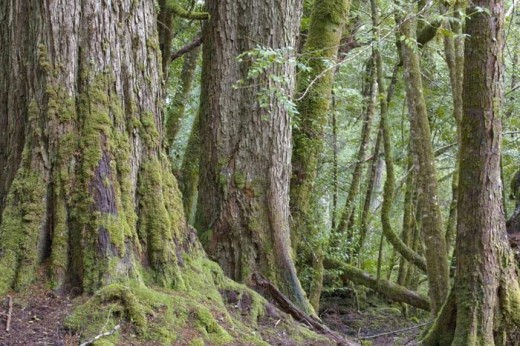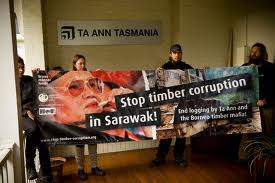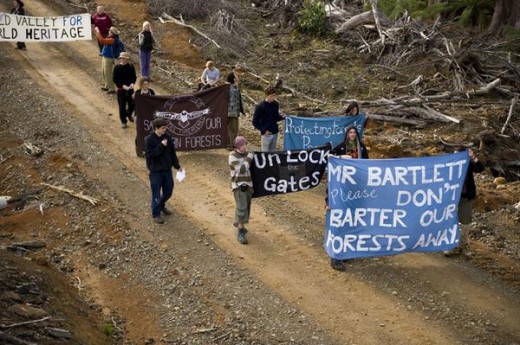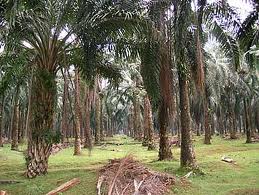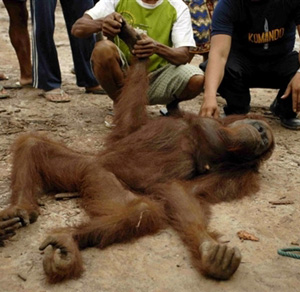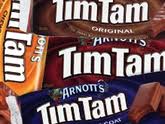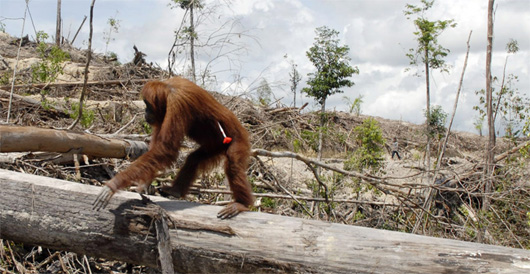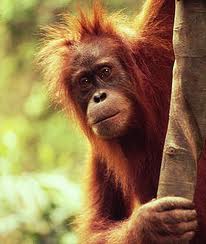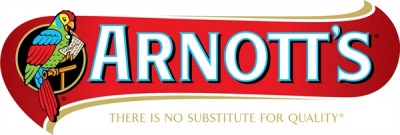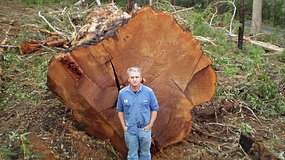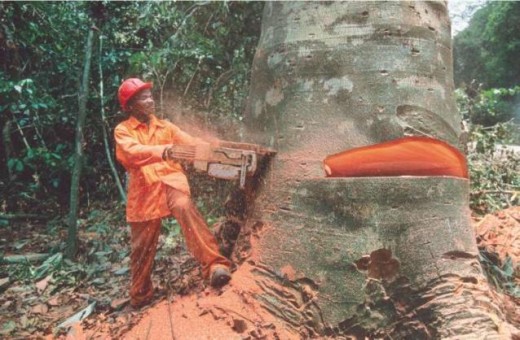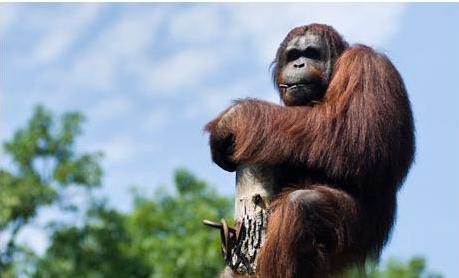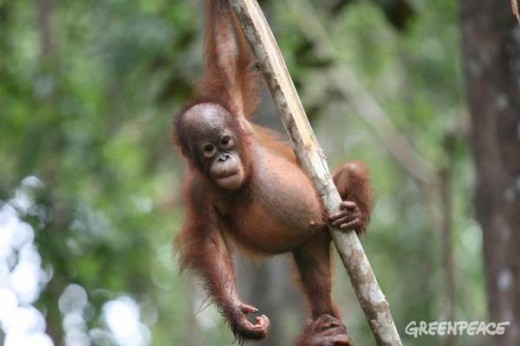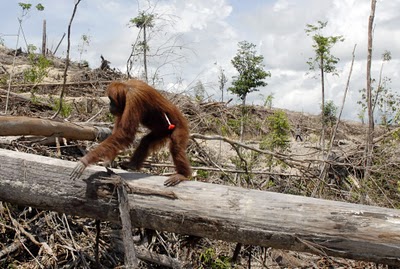Wildlife: Vietnamese officially most backward
Thursday, July 26th, 2012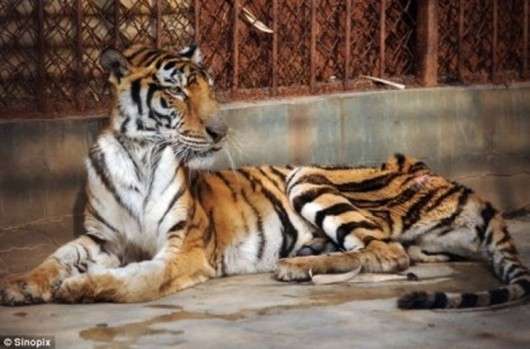 An emaciated Tiger in a Vietnamese farm cage awaits slaughter for TCM Tiger Parts
A mascot of an evil, barbaric and low-life society
An emaciated Tiger in a Vietnamese farm cage awaits slaughter for TCM Tiger Parts
A mascot of an evil, barbaric and low-life society
.
Vietnam is the most backward country for the illegal wildlife trade according to the latest wildlife report by the World Wildlife Fund (WWF).
Despite the growing middle class of Vietnam, the cultural practice of wildlife witchcraft quackery persists. It is this new wealth that is enabling more Vietnamese to drive the slaughter of wlidlife such as Rhinos, Elephants and Tigers for their body parts. The worse ‘demand countries’ for wildlife parts according to the WWF are Vietnam, China and Thailand.
The demand in wildlife parts is mainly driven from Traditional Chinese Medicine (TCM), which is an ancient backward cult in witchcraft quackery. The TCM witchdoctors prey on superstitious simpletons who think drinking tiger bone wine will cure chronic ailments. The TCM Barbaric Cult is a global chronic ailment in superstitious barbarism that is driving sadistic persecution of precious endangered wildlife. TCM is no different to the Khmer Rouge, except the TCM Barbaric Cult targets wildlife instead of people.
They evangelise TCM cures anything from fatigue, stroke, cancer, back pain, migraine and low libido, which is all misleading lies. It has its own quack terms such as ‘Yin Deficiency’, ‘Yang Deficiency’, ‘Qi Stagnation’. TCM dimwits certainly have ‘deficiency’ alright in the intelligence department. Whatever the hocus-pocus names, TCM is backward, barbaric, sadistic, cruel, illegal, and doesn’t bloody well work anyway. Only sad simpletons would spend a cent on quackery. Those who traffick in wildlife parts deserve the same fate as the wildlife.
.
TCM relies on the illegal black market in wildlife parts trafficking. It is overdue for the backward practices of TCM to be outlawed globally.
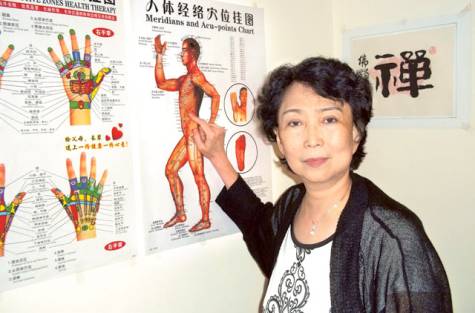 A TCM practitioner plying her trade in Yin/Yang Bollocks
A TCM practitioner plying her trade in Yin/Yang Bollocks
The following articles highlight the problem of the increasing illegal trade in wildlife parts for Traditional Chinese Medicine. When one visits the cities of these countries and see the every inctreasing shining skyline, one can be mistaken for believing one is entering a modern civilisation.
.
‘Vietnam tops wildlife crimes table’
[Source: ‘Vietnam tops wildlife crimes table’, by Kevin Heath, 20120723, ^http://wildlifenews.co.uk/2012/vietnam-tops-wildlife-crimes-table/]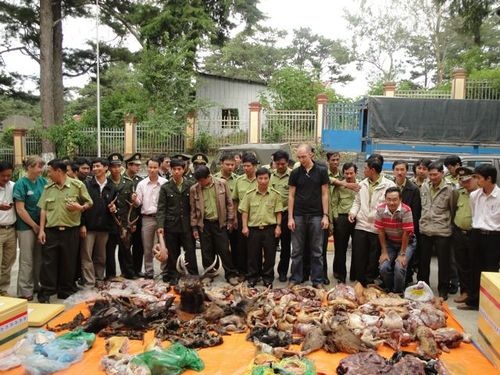 Cache of wildlife parts in Vietnam – the entrails of a barbaric cult
Cache of wildlife parts in Vietnam – the entrails of a barbaric cult.
One the eve of the opening of the latest CITES session the wildlife group WWF has released a report that shows Vietnam is the worse country for the illegal wildlife trade. In the traffic light system used by the WWF to rank countries Vietnam scored a red in trade in rhino and tigers with a yellow card for elephants.
The new report called Wildlife Crime Scorecard looked at 23 range nations as well as transit countries and the final consumer countries of parts for three species – elephant, rhino and tiger. Read Report: ^http://awsassets.panda.org/downloads/wwf_wildlife_crime_scorecard_report.pdf [>Read Report (3MB, pdf)]
.
“It is time for Vietnam to face the fact that its illegal consumption of rhino horn is driving the widespread poaching of endangered Rhinos in Africa, and that it must crack down on the illegal rhino horn trade. Viet Nam should review its penalties and immediately curtail retail markets, including Internet advertising for horn,” said Elisabeth McLellan, Global Species Programme manager at WWF.
A number of Vietnamese people have been arrested over recent years in South Africa for being involved in rhino smuggling. Even some Vietnamese diplomats have been caught involved in the trade.
China is given a yellow card for its involvement in the elephant ivory trade. The country has been highlighted as having inadequate management of its legal ivory market and this offers a conduit for illegally poached ivory to find a legitimate market.
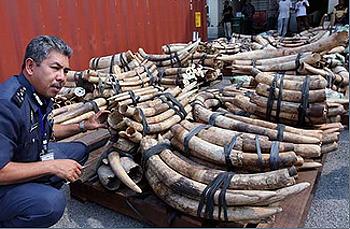 Tusks of Elephants savagedly butchered for TCM, their tusks chainsawed off while still alive.
This is a TCM stockpile of tusks intercepted in a shipping container in Malaysia
Tusks of Elephants savagedly butchered for TCM, their tusks chainsawed off while still alive.
This is a TCM stockpile of tusks intercepted in a shipping container in Malaysia
.
 Skulls of Cambodians savagedly butchered by the Khmer Rouge
This is a stockpile of human skulls in the Tuolsleng Genocide Museum in Phnom Penh
Skulls of Cambodians savagedly butchered by the Khmer Rouge
This is a stockpile of human skulls in the Tuolsleng Genocide Museum in Phnom Penh
.
The WWF reports calls on the Chinese government to dramatically improve its enforcement of the ivory market. It also calls on the government to remind its workers involved in major projects in Africa that anyone caught importing illegal wildlife products into China would be prosecuted, and if convicted, severely penalized.
While China got a yellow card for the ivory trade Thailand scored a red due to a legal loop-hole that makes it easy for illegally poached ivory to enter the luxury goods market.
“In Thailand, illegal African ivory is being openly sold in up-scale boutiques that cater to unsuspecting tourists. Governments will be taking up this troubling issue this week. So far Thailand has not responded adequately to concerns and, with the amount of ivory of uncertain origin in circulation, the only credible option at this stage is a ban on ivory trade,” McLellan said.
There is good news in the report as well. The WWF commends the countries from central Africa who recently signed a multinational agreement to tackle poaching.
“Although most Central African countries receive yellow or red scores for elephants, there are some encouraging signals. Last month Gabon burned its entire ivory stockpile, to ensure that no tusks would leak into illegal trade, and President Ali Bongo committed to both increasing protections in the country’s parks and to ensuring that those committing wildlife crimes are prosecuted and sent to prison.” said WWF Global Species Programme manager Wendy Elliott.
The brightest spot of the report though goes to Nepal which last year, 2011, saw no losses to its rhino population due to improvements to anti-poaching and other law enforcement efforts.
.
‘Vietnam gets failing grade in WWF’s illegal wildlife trade report card‘
[Source: ‘Vietnam gets failing grade in WWF’s illegal wildlife trade report card’, by Wynne Parry, LiveScienceSun, 20120722, ^http://www.mnn.com/earth-matters/animals/stories/vietnam-gets-failing-grade-in-wwfs-illegal-wildlife-trade-report-card] .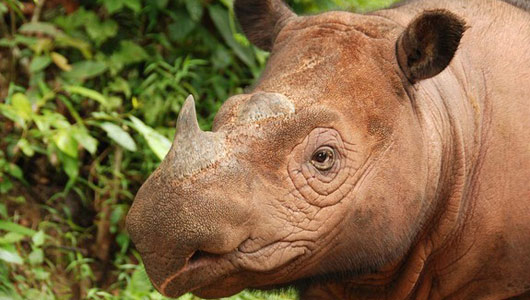 Sumatran Rhino (Dicerorhinus sumatrensis)
Members of the species once inhabited rainforests, swamps and cloud forests in India, Bhutan, Bangladesh, Myanmar, Laos, Thailand, Malaysia, Indonesia, and China.
In historical times they lived in southwest China, particularly in Sichuan.
But with TCM barbarism they have become persecuted and are now critically endangered,
with only six substantial populations in the wild: four on Sumatra, one on Borneo, and one in the Malay Peninsula.
(Photo: Bill Konstant/International Rhino Foundation)
Sumatran Rhino (Dicerorhinus sumatrensis)
Members of the species once inhabited rainforests, swamps and cloud forests in India, Bhutan, Bangladesh, Myanmar, Laos, Thailand, Malaysia, Indonesia, and China.
In historical times they lived in southwest China, particularly in Sichuan.
But with TCM barbarism they have become persecuted and are now critically endangered,
with only six substantial populations in the wild: four on Sumatra, one on Borneo, and one in the Malay Peninsula.
(Photo: Bill Konstant/International Rhino Foundation)
.
Rhinoceroses are poached for their horns that are then sold on the global black market to collectors and for medicinal purposes.
A conservation group, the World Wildlife Fund, has put together a report card ranking 23 nations’ compliance with an international treaty regulating the trade in wild animals. The report card focuses on three species sought after on the international black market: elephants, tigers and rhinoceroses, and evaluates how well certain countries have held up their commitments as part of the treaty.
“These are just three species, and they are probably the three most talked about, so they are a kind of bellwether for wider problems,” said Colman O Criodain, wildlife trade specialist with the WWF.
The report looks at countries where these animals originate and must travel through, as well as the countries where they arrive for sale. There were some bright spots: India and Nepal received green marks for all three species, showing they had made progress toward complying with the treaty and enforcing policies to prevent the illegal trade.
Many countries, however, received red marks indicating they are failing to uphold their commitments under the treaty.
There have already been consequences for animals. In the last decade, the western black rhino went extinct and the Indochinese Javan rhinoceros was eradicated from Vietnam. Poaching played a crucial role, according to the International Union for Conservation of Nature.
Other subspecies of these large, plant-eating creatures are driven by demand for their horns. In Vietnam, demand for rhino horn has boomed thanks to rumors it has healing and aphrodisiac properties, O Criodain said.
 For Asians seeking aphrodisiacs?
Viagra is proven to work, but TCM is bollocks
For Asians seeking aphrodisiacs?
Viagra is proven to work, but TCM is bollocks
.
The report calls out Vietnam, which WWF says is the top destination for South African rhino horn, saying Vietnam’s penalties for participating in the illegal trade are weak and legal measures are insufficient to curtail illegal trade on the Internet. “Despite numerous seizures elsewhere implicating (Viet Nam), there has been no recorded seizure of rhino horn in the country since 2008,” reads a statement issued by WWF.
The Convention on International Trade in Endangered Species of Wild Fauna and Flora, a treaty signed by 175 nations, makes nearly all commercial trade in rhino horns, elephant ivory, tiger parts and other species threatened with extinction illegal. In addition, signatories committed to regulating trade within their borders.
WWF ranked nations’ compliance with the treaty — evaluating whether or not the nation had adopted policies that supported the treaty — and the nations’ enforcement of those policies.
A nation could have good laws on the books but fail to enforce them. For instance, China has laws tightly controlling the sale of elephant ivory. However, it does not have a strong record of enforcing them, O Criodain said.
The report card is not comprehensive; rather it is a snapshot that focuses on certain countries that face the highest levels of illegal trade in these three species. Countries from which a particular species has been eradicated, such as Central Africa which has lost all of its rhinos, escaped an evaluation, O’Criodain noted.
The evaluation is based on government announcements reported in media, CITES documentation and information collected by Traffic, a wildlife trade monitoring network that is a joint program of the WWF and IUCN.
.
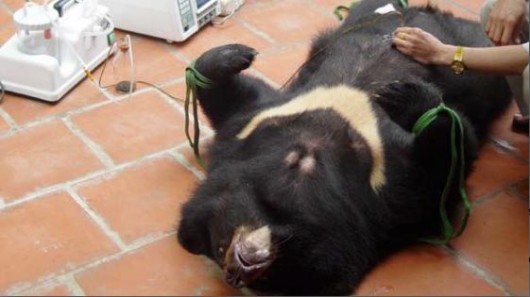 Bile being extracted from a bear’s gall bladder – while it is conscious
Bile being extracted from a bear’s gall bladder – while it is conscious(ENV photo)
.
In Vietnam, Ha Long Bear Bile Farms continue to flout the law by selling bile to Korean tourists @ $30 per cc.
Vietnam’s bears are being pushed to the edge of extinction according to ENV, primarily due to the illegal hunting and trade to support the demand for bear bile used as a traditional form of medicine (TCM). Hundreds of Asian tourists including many Koreans, visit per week, watch the extraction process, drink bear gall wine and pay $30 per CC for take-away bile. The plight of these bears is truly pitiful.
Most of the approximately 3,500 bears in Vietnamese farms are thought to have been caught as cubs in the wild and then raised for the painful extraction of bile from their gall bladders.
.
ENV produced this powerful public service announcement to persuade people not to drink bear bile wine.
.
[Source: ‘Spotlight on conservation: Education for Nature-Vietnam’, by Wild Open Eye, 20120301, ^http://wildopeneye.wordpress.com/2012/03/01/spotlight-on-conservation-education-for-nature-vietnam/].
‘Vietnam, Laos and Mozambique do least to halt trade in animal parts: WWF’
[Source: ‘Vietnam, Laos and Mozambique do least to halt trade in animal parts: WWF’, by Reuters, 20120723, ^http://articles.timesofindia.indiatimes.com/2012-07-23/flora-fauna/32803700_1_elephant-ivory-animal-parts-tiger-parts].
‘Vietnam, Laos and Mozambique are the countries that do the least to crack down on an illegal trade in animal parts that is threatening the survival of elephants, rhinos and tigers, the WWF conservation group said on Monday.
In its ‘Wildlife Crime Scorecard’ report, it said 23 countries surveyed mostly in Africa and Asia, the main sources and destinations of animal parts, could all do more to enforce laws banning a trade that WWF said was increasingly run by international crime syndicates.’
.
‘Vietnam proposes legalizing use of tiger parts in traditional medicines’
[Source: ‘Vietnam proposes legalizing use of tiger parts in traditional medicines’, by Occupy For Animals, ^http://www.occupyforanimals.org/vietnam-proposes-legalising-use-of-tiger-parts-in-traditional-medicines-2012.html].
‘Vietnam has proposed a move that activists allege would boost tiger poaching across the world. The country has proposed legalising the use of parts of captive bred tigers that die of natural causes in traditional medicines. If approved, this is likely to spur demand for body parts of the big cat in the international market and hit tiger conservation efforts currently underway. The Ministry of Agriculture and Rural Development (MARD) of Vietnam sent the proposal to the prime minister of the country in March this year.
The disclosure has taken the international community, which is currently discussing a coordinated strategy for recovering global tiger population in New Delhi, by shock. The proposal was brought to the notice of the tiger range countries by non-profits when they were discussing the measures to eliminate the demand for tiger parts during the 1st Stocktaking Meeting of the Global Tiger Recovery Programme (GTRP) between May 15 and May 17. The conference was organised by National Tiger Conservation Authority of India along with the Global Tiger Forum, Global Tiger Initiative and the World Bank to take stock of the GTRP, which was adopted in 2010 and aims at doubling the global wild tiger population by 2022. Currently, around 3,200 wild tigers thrive in Bangladesh, Bhutan, Cambodia, China, India, Indonesia, Lao PDR, Malaysia, Myanmar, Nepal, Russia, Thailand and Vietnam.
Vietnam, however, did not mention the MARD proposal in its draft GTRP implementation report, a document each of the tiger range countries submitted to explain the actions taken by their governments for tiger conservation. The proposal is part of an investigation report prepared by the MARD on the wild and captive-bred tigers in Vietnam. Around 112 tigers are kept in breeding farms in Vietnam. “According to Vietnam’s law and International Convention, any activity of trading or using tigers and tiger products is prohibited. Tiger breeding facilities therefore can gain no profit. Moreover, because of the regulations against tiger trading, these facilities don’t have specific breeding purposes,” says the report. It further states that “dead tigers (from captive facilities) can be used to make specimens and traditional medicine on a pilot basis.”
But conservationists are not pleased. “This is in contradiction of the spirit of UN Convention on International Trade in Endangered Species (CITES) and GTRP. We want to give a clear message to Vietnam that if it goes ahead with the plan, we might have to take action against it in whatever capacity we can,” says Keshav Varma, programme director of the Global Tiger Initiative of the World Bank. The tiger range countries, including Vietnam, are signatories to CITES that prohibits the trade in tiger parts and derivatives, including domestic trade.
When asked, the representative of Vietnam’s ministry of natural resource and environment said the proposal came from a different ministry and he could not say much about it. He, however, hoped that the proposal would not be approved by their prime minister. “We are appalled that a few countries promise something else on international platforms while their domestic policies imply something else. If they allow trade of dead tigers kept in captivity, many tigers will be killed in the wild and their parts will be sold under the wrap of this scheme,” says Debbie Banks of UK-based non-profit, Environmental Investigation Agency.
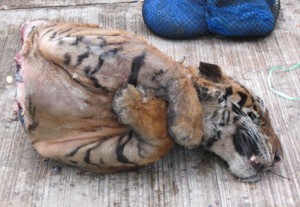 So when you visit your Ying Yang Traditional Chinese Medicine Quack,
remember this tiger suffered for your healing cult.
So when you visit your Ying Yang Traditional Chinese Medicine Quack,
remember this tiger suffered for your healing cult.
.
Is China above board?
.
In the meeting apprehensions were also expressed regarding China’s domestic policies on captive tiger breeding and trade. For long tiger bones have been used in traditional medicines and wines in China. This had made the country principal destination for tiger parts from all over the world. In 1993, China prohibited the use, manufacture, sale, import and export of tiger bone products and products labelled as containing tiger bones.
However, in 2007, the State Forestry Administration (SFA), of China issued guidelines for the registration, labelling and sale of tiger and leopard skins of “legal origin.” “This seems to contradict China’s claim that trade in tiger parts is banned in the country. We have consistently requested clarification from China over just how many skins have been registered, how many have been sold under this policy, how many have come from captive bred sources, how many are reportedly from the wild and how legality has been verified. They have never responded,” says Banks.
China has also failed to meet the CITES resolution that it would take “measures to restrict the captive population to a level supportive only to conserving wild tigers.” The captive tigers in China have reportedly increased from 6,000 in 2010 to 9,000 now. There are allegations that the captive farms stockpiles the tiger bones and other parts of dead tigers. There is no transparency from China on where these stockpiles end up. “The issue of whether stockpiling of tiger bones in the captive farms in China is for research or for commercial use needs further clarification and is a serious cause of concern. We urge that China should follow the CITES resolution of keeping the captive bred tiger population restricted to support wild population in letter and spirit,” says Rajesh Gopal, member secretary of National Tiger Conservation Authority.
.
‘Thirst is building for tiger bone wine’
[Source: Thirst is building for tiger bone wine’, by Yang Wanli (China Daily), 20100301, ^http://www.chinadaily.com.cn/metro/2010-03/01/content_9516414.htm]Roaring demand for tiger bone tonic wine during the Year of the Tiger has delighted those taking part in the underground industry but sent chills through conservationists.
Despite a national prohibition on dealing in tiger body parts, online trade and tiger farms are flourishing, leading opponents to call for additional protection of the endangered species.
“In Western countries, people believe in Western medicine but there has seldom been as much enthusiasm for traditional Chinese medicine (TCM) as there is now, especially those made from animals,” said Ge Rui, Asian Regional Director of the International Fund for Animal Welfare.
She said tiger farms are now a major threat to the species. While the farms are tolerated, the State Forest Ministry issued a notice at the end of last year stating that tiger bodies from the farms should be sealed for safekeeping.
“The government has made a great deal of effort to curb the illegal trade in rare and endangered species in recent years,” Ge said. “But their work is mainly focused on cross-border trade. The government allows the operation of tiger farms.”
According to statistics from the International Fund for Animal Welfare, there are now about 3,200 wild tigers worldwide.
In China, only about 20 tigers are thought to be left in the wild.
“The existence of tiger farms and increasing illegal trade in tiger products is seriously threatening this precious species,” she said. “In the Year of the Tiger, we should be doing more.”
Chinese animal rights groups recently launched an online campaign pushing for more protection of wild animals.
Despite the concern, consumers are still eager to get their hands on the illegal tonic wine.
“Tiger bone tonic wine will surely be popular this year,” said a seller from the Beijing Xinghuo Company.
“Nothing could be better than sending it to your relatives or leaders during the Year of the Tiger, both for good wishes and to keep them healthy.”
The company sells a wide range of wines, including a tiger bone tonic wine.
A 500 ml bottle of tiger bone wine, made in Heilongjiang province, sells for 1,380 yuan.
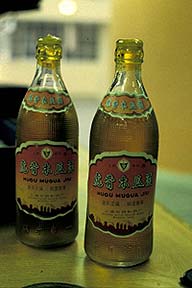 Tiger Wine – extracted from Tigers
It may as well be the cerebral fluid of Cambodians butchered at the hand of the Khmer Rouge
Tiger Wine – extracted from Tigers
It may as well be the cerebral fluid of Cambodians butchered at the hand of the Khmer Rouge
.
 Human Cerebrospinal fluid
Not as marketable in test tubes, but then TCM Cultists haven’t got around to bottling and branding this yet
Human Cerebrospinal fluid
Not as marketable in test tubes, but then TCM Cultists haven’t got around to bottling and branding this yet.
However, a bottle of tiger bone wine, said to be from Tongrentang, the place that supplied medicine to the royal pharmacy during the Qing Dynasty for 188 years, is even more expensive. Such wine, made in 1990s, sells for around 25,000 yuan.
The wine, which is believed to have medicinal properties, should improve with age, so the older the bottle, the higher the price. Those produced in the 1980s can sell for 60,000 yuan for 323 ml.
“Real tiger bone tonic wine is very popular in the market now,” said Sjkexiao, a 20-year old man who was looking to sell two bottles online that he claimed was tiger bone wine made in Tongrentang in 1984.
He said tiger bone tonic wine had been increasing in price in recent years.
Tigers have been used in traditional Chinese medicine for centuries. Tiger bone tonic wine is used in the treatment of arthritis and rheumatism.
China joined the Convention on International Trade in Endangered Species of Wild Fauna and Flora (CITES) in 1981. It imposed a ban on the harvesting of tiger bones and outlawed all trade in tiger body parts in 1993.
As a result, tiger bone remedies were removed from TCM dictionaries.
“Medicines with parts from rare animals are not allowed to be sold now,” said a staff member, surnamed Zhang, at a Cachet pharmacy.
She suggested another medicinal wine, named Hongmao Medical Wine, that was priced at 250 yuan and which claimed to contain leopard bones.
“Money cannot buy a genuine bottle of tiger bone wine because of its scarcity,” she said. “You can never find such medicine in the stores now. Wine containing real tiger bones is really more effective than others.”
However, doctors were quick to question the medicinal value of tiger bone tonic.
“It is the same as other medicinal wines,” said Yue Debo, a doctor with more than 20 years’ experience in the department of orthopedics at the China-Japan Friendship Hospital. “It doesn’t have any miraculous effect.”
.
Comment: by Willson 20111230:
“This is why I will never allow any of my companies or affiliates to do business with the Chinese. The Chinese are unworthy of respect and therefore unworthy of becoming a trade partner. The trade in tiger bone wine is not an underground industry. It is a mainstream industry condoned by the Chinese government. My companies will never sell technology to the Chinese so long as this and other wildlife is threatened with government sanctioning.”
.
Comment: by Dan 2011-12-30 06:37
“China is shameful!“
.
‘India lucrative target for illegal wildlife trade’
[Source: ‘India lucrative target for illegal wildlife trade’, 20120628, Zee News,^http://zeenews.india.com/news/eco-news/india-lucrative-target-for-illegal-wildlife-trade_784409.html]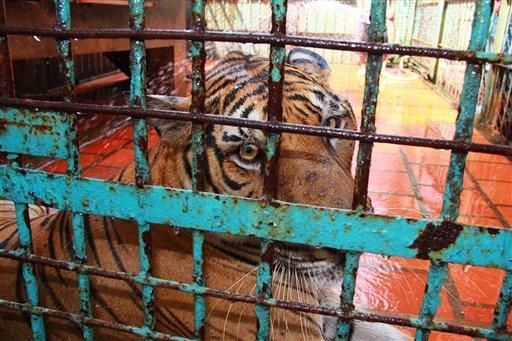 Abject Fear for Reason
Abject Fear for Reason
.
India remains a “lucrative target” in the USD 20 billion illegal trade of wildlife articles per year, an official document says.
“The most serious and immediate risk to many species is poaching for wildlife trade. …South Asian countries account for 13 to 15 per cent of the world’s biodiversity and so remain a lucrative target of the trade,” says the report prepared by the Environment Ministry.
Wild animals are killed for the flourishing illegal international trade in their skins, bones, flesh, fur, used for decoration, clothing, medicine, and unconventional exotic food, says the Environmental and Social Framework Document for “Strengthening Regional Cooperation in Wildlife Protection in Asia”.
Victims of the trade include the iconic tiger and elephant, the snow leopard, the common leopard, the one-horn rhino, pangolin, brown bear, several species of deer and reptiles, seahorses, star tortoises, butterflies, peacocks, hornbills, parrots, parakeets and birds of prey, and corals, it says.
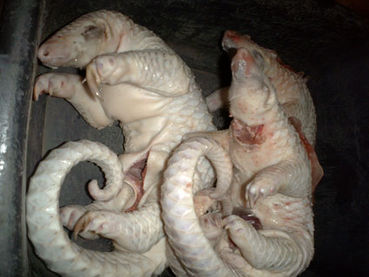 Pangolines poached for TCM
Pangolines poached for TCM
.
“The primary market for many of these products is outside South Asia, often in East Asia for items of presumed pharmacological utility,” says the document is prepared for financial assistance from the World Bank under regional International Development Association (IDA) window.
Noting that the wildlife trade is “big business”, it said due to the clandestine nature of the enterprise, reliable estimates of the composition, volume and value of the trade remain elusive.
“The International Criminal Police Organization (INTERPOL) suggests that the global value of the illegal wildlife related trade exceeds USD 20 billion per year and probably ranks third after narcotics and the illegal weapons trade,” it said.
The report says that poaching techniques are “extremely gruesome”.
“The more egregious methods include skinning or dehorning live animals, and transportation of live creatures in inhuman conditions,” it says.
Particularly damaging is the banned trade in tiger parts much of which is used for its presumed pharmaceutical benefits.
“The World Chinese Medicine Society has declared that tiger parts are not necessary in traditional medicines and that alternatives are available and effective. Yet the illegal trade still flourishes.
Poaching has become so intense that tigers have disappeared from many parks throughout Asia.
“Nowhere has the impact been greater than in India and Nepal which remain the bastions of tiger conservation,” says the document and added that Nepal has emerged as the transit hub for the trade in illegal wildlife commodities destined for consumption in East China.
“Laos is recognized as both a source and transit country while Viet Nam is a transit hub for illegal wildlife trade,” it says.
The economic value of the illegal wildlife trade is determined primarily by cross-border factors. Wildlife are poached in one country, stockpiled in another, and then traded beyond the South Asia region.
“Lack of uniformity in enforcement can result in migration of the trade to other countries with less stringent enforcement. The trade is controlled by criminal organizations which have considerable power over the market and the prices paid to poachers and carriers, making control of the trade even more challenging,” it says.
.
‘SA breeders embrace growing Asian demand for lion bones’
[Source: ‘SA breeders embrace growing Asian demand for lion bones’, by Faranaaz Parker, Mail and Guardian, South Africa, 20120705, ^http://mg.co.za/article/2012-07-04-sa-breeders-embrace-growing-asian-demand-for-lion-bones] .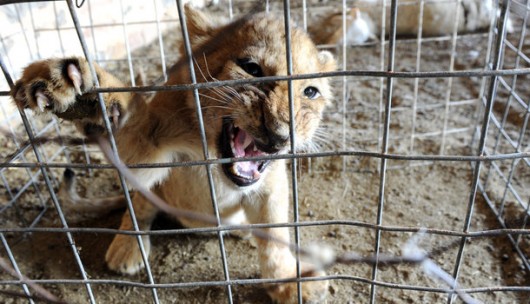
Desktop activists have joined conservationists to raise awareness about the growing demand for lion bones from users of traditional Chinese medicine, but breeders have defended the right to hunt lions born in captivity.
Last week, the online activist organisation Avaaz.com launched a petition imploring President Jacob Zuma to ban the trade of lion bones. “As citizens from around the world with great respect for South Africa and its magnificent natural heritage, we appeal to you to ban the cruel and senseless trade in lion bones and organs, which is encouraging an industry that could drive lions to the brink of extinction,” says the petition, which garnered over 630 000 signatures in a week.
Lion bones are a sought-after ingredient used to make lion bone wine, a substitute for the traditional Asian cure-all, tiger bone wine, which fetches up to R250 000 a case at illicit auctions.
Conservationists have warned that captive breeding and canned hunting programmes in South Africa are providing a source for the lion bone trade. Canned lion hunting is legal in South Africa, as is the exporting of lion carcasses. Lion populations across Africa have been reduced by 90% over the past 50 years, but lion breeders say their operations have nothing to do with the continent’s wild populations.
.
The price of trophies
.
Breeders can benefit financially a number of times from the same lion. Cubs are often rented as tourist attractions and visitors pay to pet and interact with them. The fee paid by visitors is then fed back into captive breeding programmes. As adults, the lions are sold to hunters in canned hunting arrangements.
Farmers and hunting operators charge in the region of about $20 000 (R160 000) as a “trophy price” and hunters can expect to pay around $18 000 (R145 000) for other services, excluding taxidermy.
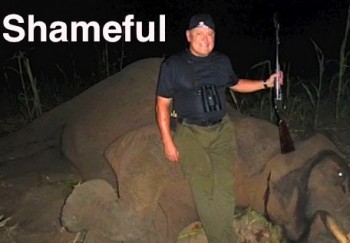 Bob Parsons – Elephant Killer
Bob Parsons – Elephant Killer
But the hunters are only interested in the head and skin of the lion, and often leave the bones with the breeder, who can then sell the bones, with a government permit, to Asian buyers for use in making lion bone wine.
It’s estimated that a complete lion skeleton can sell for as much as R80 000. Last year it emerged that over 1 400 lion and leopard trophies were exported from the country in 2009 and 2010.
.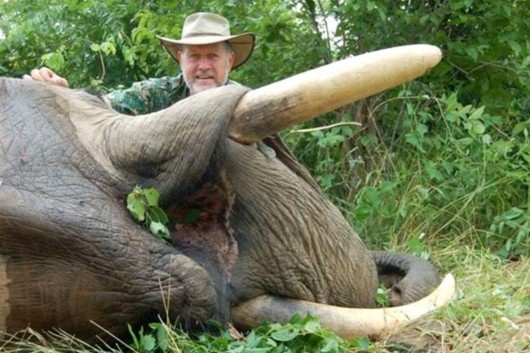 Robert Borsak – elephant trophyist
New South Wales Shooters and Fishers MP Robert Borsak with an elephant shot on safari in Zimbabwe, June 2008.
[Source: ABC, ^http://www.abc.net.au/news/2011-04-13/nsw-mp-robert-borsak-with-an-elephant-shot-on/2619226]
Robert Borsak – elephant trophyist
New South Wales Shooters and Fishers MP Robert Borsak with an elephant shot on safari in Zimbabwe, June 2008.
[Source: ABC, ^http://www.abc.net.au/news/2011-04-13/nsw-mp-robert-borsak-with-an-elephant-shot-on/2619226]
.
According to the environmental affairs minister, in 2010, 153 live lions were exported as well as 46 lion skins, 235 carcasses, 592 trophies, 43 bodies and 41 skulls. It was noted that these figures were incomplete as the provinces had not yet captured all their data. Yet there was a 150% growth in exports of lion products from 2009 and 2010.
.
‘Amplifying an illegal industry
.
Chris Mercer, director of the Campaign Against Canned Hunting, said hunting captive-bred lions was “hideously damaging” to conservation. “It’s farming with alternative livestock. They’re only doing it because they make more money farming lions than they do sheep or cattle. But they don’t realise they’re harming the wild populations by creating and amplifying an illegal industry and allowing it to prosper,” he said.
Mercer said he believes the export of lion bones and in fact the entire canned hunting industry should be banned. He pointed out that there was a huge overlap between the rhino horn and lion bone trade. “Many of the Asiatic groups dealing with lion bones are the same people dealing with rhino horn,” he said.
He criticised government for taking a simplistic view of the matter and overlooking the dangers the lion bone trade poses. “The very people who are doing our rhino horn [poaching] are making money out of this. You can just imagine how the illegal trade is going to piggy-back itself onto this legal trade,” he warned.
Banning the entire trade will be difficult. There are almost 200 lion breeders in the country, many of whom are part of the powerful Predator Breeders’ lobby group. The breeding of lions for trophy hunting is a lucrative business. In 2009, the economic value of trophy hunting was estimated to be between R153-million and R832-million.
.
Rapidly going extinct
.
But Pieter Kat, director of the UK-based conservation organisation LionAid, said a lot could be achieved simply by placing a ban on the export of lion bones. Lions are listed on appendix two of the Convention on International Trade in Endangered Species of Wild Fauna and Flora, which means that a government permit is needed to export any lion products. “It will take a position of responsibility by South Africa to say, ‘No more, we will not allow this,'” he said.
“South Africa is within its rights [to] say no more export permits,” said Kat.
Kat said that while one could argue about the ethics of breeding lions just to be shot, it was important to bear in mind that whatever South Africa did in terms of its legal trade in lion bones would affect wild lion populations all over the continent.
Kat pointed out that there are only about 20 000 lions left on the entire continent – down from about 200 000 in the 1970s. In the past few years Côte d’Ivoire, Ghana and the Republic of Congo-Brazzaville have lost all their lions, while countries like Nigeria, Malawi and Senegal have only a few dozen lions left.
“We’re dealing with a species that is rapidly going extinct but because we are not really focused on lions – we’re talking about elephants and rhinos – it’s a silent extinction,” he said.
He warned that allowing the trade in lion bones to proliferate would stimulate a demand for the product. “Soon someone will [realise] it’s cheaper for to poach than to pay the owner of a captive animal to get the bones,” he said.
But Professor Pieter Potgieter, chairperson of the South African Predator Breeders’ Association, defended the industry saying there is little difference between breeding lions and any other mammal. “Chickens are killed by humans. How are lions different from them?” he asked.
“In principle a lion is not more or less than a crocodile, an ostrich or a butterfly. It’s a form of life. Breeding animals for human exploitation is a natural human process,” he said.
Potgieter said that breeding and hunting lions was only deplorable in the eyes of the public because a “sympathetic myth has been created about the lion as the king of the animals”.
He justified the practice, saying the export of lion bones is a legal trade authorised by the department of environmental affairs and denied that South Africa’s approach to captive breeding and canned lion hunting was feeding into the Asian demand for lion bones. “I don’t think that market is being created by the South African situation. That would happen anyhow and the more the Asian tiger gets extinct, the more people will try to get hold of lion bones as a substitute,” he said.
In 2007 former environmental affairs minister Marthinus van Schalkwyk attempted to put the brakes on canned lion hunting. It was widely reported that the activity had been banned in the country but this is not the case.
Some changes to legislation were made but the Supreme Court of Appeal ruled in favour of the Predator Breeders’ Association and overturned an attempt to enforce a two-year waiting period during which a captive-bred lion would be allowed to roam freely in an extensive wildlife system before being hunted, which conservationists had labeled an attempt to “pretend that the lion is wild”.
The environmental affairs department did not respond to questions by the time of going to print.’
.
‘Bodies of 14 rare Sumatran tigers seized’
[Source: ‘Bodies of 14 rare Sumatran tigers seized’, by AFP, 20120719, ^http://articles.timesofindia.indiatimes.com/2012-07-19/flora-fauna/32746788_1_sumatran-tigers-tiger-body-parts-illegal-wildlife-trade].
‘Indonesian police seized 14 preserved bodies of critically-endangered Sumatran tigers in a raid on a house near Jakarta, a spokesman said Thursday. A man identified as F.R. was arrested Tuesday in a suburban area of Depok suspected of his involvement in the illegal wildlife trade, national police spokesman Boy Rafli Amar told AFP.
“We confiscated whole preserved bodies of 14 tigers, a lion, three leopards, a clouded leopard, three bears and a tapir and a tiger head,” he said, adding that investigations were ongoing.
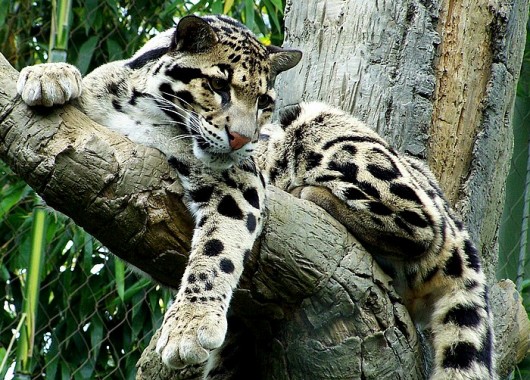 The Clouded Leopard (Neofelis nebulosa)
Is a felid found from the Himalayan foothills through mainland Southeast Asia into China, and has been classified as vulnerable in 2008 by IUCN.
Poached for barbaric TCM.
.
The Clouded Leopard (Neofelis nebulosa)
Is a felid found from the Himalayan foothills through mainland Southeast Asia into China, and has been classified as vulnerable in 2008 by IUCN.
Poached for barbaric TCM.
.
.
‘The factory farm tigers being turned into wine’
[Source: ‘The factory farm tigers being turned into wine’, by Danny Penman, 20070312, UK Daily Mail, ^http://www.dailymail.co.uk/news/article-441632/The-factory-farm-tigers-turned-wine.html] Doomed: One of the tigers at Xiongsen animal park being turned into wine
Doomed: One of the tigers at Xiongsen animal park being turned into wine
.
Cruel almost beyond belief, this Chinese farm breeds hundreds of tigers in rows of battery cages … so they can be killed and turned into wine…
King, the Siberian tiger, stares at me through the bars of his cage. His two beautiful, graceful companions pace back and forth across their tiny compound. They look crushingly bored. The most exciting thing they can do is paw mournfully at the dirty pools of rainwater on the floor of their cage.
Although the Xiongsen tiger park, near Guilin in south-east China, appears to be a depressingly typical Third World zoo, with a theme park restaurant and open areas where tigers roam, it actually hides a far more sinister secret: it’s a factory farm breeding tigers to be eaten and to be made into wine.
In row upon row of sheds, hundreds of tigers are incarcerated in battery-like cages which they never leave until they are slaughtered.
Visitors to the park can dine on strips of stir-fried tiger with ginger and Chinese vegetables. Also on the menu are tiger soup and a spicy red curry made with tenderised strips of the big cat. Visitors can wash it all down with a glass or two of wine made from Siberian tiger bones.
A waitress at the farm’s restaurant tells me proudly: ‘The tiger meat is produced here. It’s our business. When Government officials come here, we kill a tiger for them so they have fresh meat. Other visitors are given meat from tigers killed in fights. We now have 140 tigers in the freezer.
“We also sell lion meat, bear’s paw, crocodile and snake. The bear’s paw has to be ordered in advance as it takes a long time to cook.”
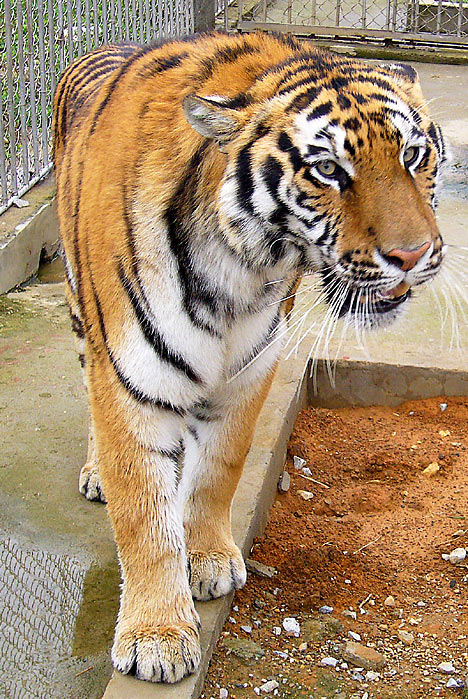 Hundreds of tigers are incarcerated in battery-like cages by the Chinese TCM Cultists
Hundreds of tigers are incarcerated in battery-like cages by the Chinese TCM Cultists
.
The waitress clearly does not care that she is selling meat and wine from endangered species. She is not worried that selling them is against Chinese and international law, and helps to fuel the poaching that is driving tigers to extinction.
Tigers and other endangered species are being reared on an industrial scale throughout China, despite international treaties forbidding this. The Mail discovered three factory farms breeding tigers in China. The Guilin farm alone has 1,300 tigers, including the incredibly rare and elusive Siberian sub-species.
It rears and slaughters Bengal, South China and White tigers. More than 300 African lions and 400 Asiatic black bears are also reared here for food and traditional Chinese medicines.
The Chinese authorities claim that farms like the one at Guilin are a vital part of the country’s conservation efforts, and that they will one day release these endangered creatures back into the wild.
But my visit to the Xiongsen Bear and Tiger Mountain Village shows their real intention could not be more different. For the fact is that these animals could never survive in the wild.
Having spent their lives in tiny, battery-style units, they cannot hunt and would be dead within days of being released. Each shed at the tiger farm – and I saw at least 100 – houses between three and five tigers in a space no larger than a typical family living room. In relative terms, they have about as much space as a battery hen.
The animals have all been bred on the farm. The cubs are taken from their mothers at three months and put in a kindergarten. I saw around 30 tiger cubs in this creche, where they stay until they are old enough to be transferred to the battery units.
Many of the youngsters kept leaping at the fencing. The younger ones simply wanted to play like kittens. The older cubs were already showing signs of stress.
Tigers are naturally solitary creatures that roam over dozens of square miles, so it’s hardly surprising that life in the cages drives them insane. I saw numerous examples of stress-related repetitive behaviour.
The mature animals paced back and forth across their cages for hours on end – three steps forward, three steps back. Some hurled themselves at the bars of their prison cells, while others simply stared into space.
Over-crowding drives the creatures to attack each other, often resulting in death. Officially it is only the tigers killed in such fights that can be eaten or turned into wine. But it is clear that many of them die as a result of a bullet to the head.
They are not the only animals killed. For entertainment, visitors to the animal park can watch the ‘live killing exhibition’, a sick spectacle in which animals are ‘hunted’ and torn to pieces by tigers while onlookers cheer.
I watched in horror as a young cow was stalked and caught by a tiger. Its screams filled the air as it struggled.
.
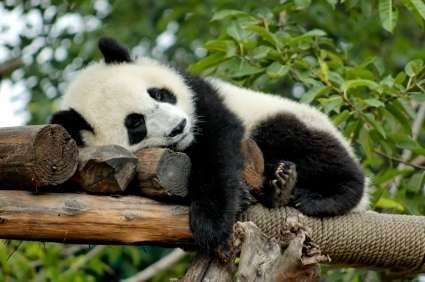 So Visit China – see its wildlife, taste its wildlife, souvenir its wildlife!
Not sure what TCM says how Panda Parts heal you or give you a hard on?
So Visit China – see its wildlife, taste its wildlife, souvenir its wildlife!
Not sure what TCM says how Panda Parts heal you or give you a hard on?
.
A wild tiger would dispatch its prey within moments, but these tigers’ natural killing skills have been blunted by years of captivity. The tiger tried to kill – tearing, biting at the cow’s body in a pathetic-looking frenzy – but it simply didn’t know how. Eventually, the keepers stepped in and put the cow out of its misery.
Virtually all the tigers from the Guilin farm end up at a winery 100 miles to the north, their carcasses dumped in huge vats of rice wine and left to rot for up to nine years.
The Chinese believe that the tiger’s strength passes into the wine as its body decomposes. They also believe that it is a powerful medicine that wards off arthritis, strengthens bones and acts as a general tonic.
Smelling like a mixture of methylated spirits, antiseptic and congealed meat, it is difficult to believe that anyone would willingly drink it, and yet people pay up to £100 a pint for it.
The Guilin farm also has its own small winery and acts as a distribution centre across China. The distribution manager showed me around with a Chinese tourist.
A small dingy office acts as the nerve centre of the warehouse. On the wall were charts showing that day’s deliveries of tiger wine across China. Six crates were sent to Wuhan and another to Tianjing. Six crates of ‘powdered bear’ were sent to Shanghai. Numerous other cities and countless deliveries were also listed.
We were led into the warehouse, where I was hit with the disgusting and potent aroma of tiger wine. I was led past countless crates containing the foul-smelling brew. In the corner of the warehouse was a huge brown earthenware vat. It must have held at least 50 gallons, and its contents were probably worth around £12,000.
“We have three ages of wine,” said the manager. “Three, six or nine-years old. It helps with arthritis and strengthens old people’s bones.”
She slid aside the lid of the earthenware vat to reveal a reddish-brown liquid with an overpowering smell of meths. A piece of string was pulled out of the vat. Attached to the end was a tiger’s rib cage. Small slivers of dark red flesh could still be seen clinging to the bone, even though it had probably been in the vat for at least three years.
The manager then filled up an old plastic water bottle with a pint of wine and handed it to my fellow tourist. He paid £30 for it.
Whatever westerners think of tiger wine, the Chinese regard it as a potent drink with almost magical qualities. In the past, a Chinese doctor may have prescribed small quantities of wine for a short period of time.
But in recent years, big companies have moved into the market and industrialised all parts of the industry. Now the wine is becoming an essential drink for China’s corrupt bureaucrats and the nation’s nouveaux riches.
Conservationists say tiger farming is not only barbaric, it could lead to the animal’s extinction in the wild.
“It is stimulating demand for meat and wine, and this will inevitably lead to more poaching,” says Grace Gabriel, of the International Fund for Animal Welfare.
“It costs £5,000 to raise a tiger from a cub to maturity in one of these farms, while it costs no more than £20 in India to poach one. On the market, a dead tiger can fetch £20,000.
“With such a huge margin, it is inevitable that more people will poach wild tigers if demand increases,” she adds. “There are only a few thousand tigers left in the wild, and the last thing they need is increased demand for their body parts.”
If present trends continue, tigers could be extinct in the wild within a decade. Three subspecies have already vanished. Chinese tigers are down to a pitiful 20 animals in the wild and are “functionally extinct”.
There are only about 450 Siberian tigers left in Russia’s Far East. The remaining 3-4,000 are sparsely scattered across India, Nepal and South-East Asia.
The trouble is that, as tigers become rarer in the wild, their ‘street value’ increases, which in turn encourages even more poaching.
Tigers have already become extinct in India’s most famous reserve at Sariska. Numbers have plunged in several other reserves, too.
Most of these tigers will have been sold to traders in China. The Chinese authorities do virtually nothing to clamp down on this illegal trade, and many corrupt bureaucrats and police earn substantial sums from it.
And demand is continuing to increase as ever more bizarre uses for tigers are promoted. Tiger whiskers are used to ‘cure’ laziness and protect against bullets. Their brains, when mixed with oil and rubbed on the skin, are promoted as a cure for acne. Penises are used as aphrodisiacs, while hearts apparently impart courage, cunning and strength.
Tiger farmers also have their eyes on the 2008 Olympics in Beijing. They hope that a huge influx of tourists will lead to increased demand for tiger wine.
Although it is illegal to trade internationally in such tiger products as wine, the Chinese are lobbying hard to get the law relaxed. This June, the Chinese Government is expected to press the Convention on the International Trade in Endangered Species (CITES) to allow the trade in ‘medicines’ such as wine produced from farmed tigers.
If agreed, it will lead to a massive increase in tiger farming and tens of thousands of these noble beasts will spend their lives in battery cages.
If the Chinese get their way, then it will almost certainly drive the tigers over the cliff into extinction.
It is almost too late to save this magnificent creature – but not quite.
.
Further Reading:
.
[1] ‘Tiger Bone Rhino Horn – The Destruction of Wildlife for Traditional Medicine’, by Richard Ellis, published by Shearwater, USA, 2005, ^http://www.scribd.com/doc/45308802/Tiger-Bone-Rhino-Horn-The-Destruction-of-Wildlife-for-Traditional-Medicine.
 The Tiger – an animal far more intelligent that any TCM dimwit
The Tiger – an animal far more intelligent that any TCM dimwit
